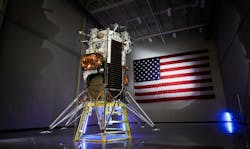NASA to demostrate autonomous navigation system on Moon
WASHINGTON - Demonstrating autonomous navigation, the Lunar Node-1 experiment, or LN-1, is a radio beacon designed to support precise geolocation and navigation observations for landers, surface infrastructure, and astronauts, digitally confirming their positions on the Moon relative to other craft, ground stations, or rovers on the move. These radio beacons also can be used in space to help with orbital maneuvers and with guiding landers to a successful touchdown on the lunar surface, Jonathan Deal writes for NASA. Continue reading original article.
The Military & Aerospace Electronics take:
14 February 2024 -“Imagine getting verification from a lighthouse on the shore you’re approaching, rather than waiting on word from the home port you left days earlier,” said Evan Anzalone, principal investigator of LN-1 and a navigation systems engineer at NASA’s Marshall Space Flight Center in Huntsville, Alabama. “What we seek to deliver is a lunar network of lighthouses, offering sustainable, localized navigation assets that enable lunar craft and ground crews to quickly and accurately confirm their position instead of relying on Earth.”
Deal writes that "the system is designed to operate as part of a broader navigation infrastructure, anchored by a series of satellites in lunar orbit as being procured under NASA’s Lunar Communications Relay and Navigation Systems project. Together, future versions of LN-1 would utilize LunaNet-defined standards to provide interoperable navigation reference signals from surface beacons as well as orbital assets."
Related: NASA's laser navigation tech enables commercial lunar exploration
Related: NASA seeks industry proposals for commercial services related to Mars exploration
Related: SpaceX launch sends four private astronauts to ISS
Jamie Whitney, Senior Editor
Military + Aerospace Electronics
